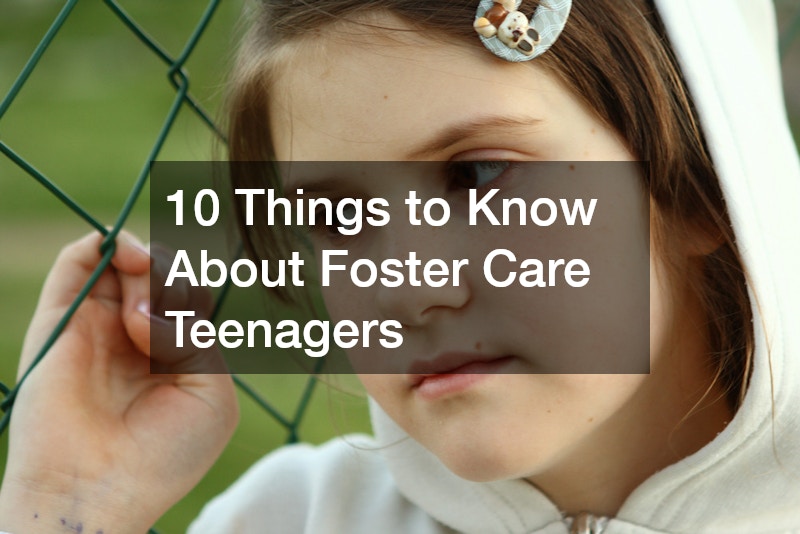
Foster care teenagers are young individuals navigating a system designed to provide temporary care and support outside of their biological homes. With unique challenges and opportunities, these teenagers require understanding, stability, and guidance. This article delves into ten critical aspects of teens in foster care, addressing common questions and shedding light on this often-overlooked group.
1. What is Foster Care?

1.1 Definition and Purpose
The foster care system provides temporary care to children and teenagers who cannot stay with their biological families due to issues like neglect, abuse, or other unsafe living conditions. The purpose of foster care is to offer a safe, structured environment for youth until they can either return to their families or find permanent homes through adoption. Foster care ensures that every child and teenager has a support system to help them grow despite challenges.
1.2 Types of Foster Care
Foster care varies depending on the needs of the child. Traditional foster care provides a stable, short-term home, while therapeutic foster care focuses on youth with specific emotional or behavioral needs. Kinship care is an arrangement where relatives or family friends step in to care for the child. Group homes serve multiple foster care teens who may require structured supervision or specialized support services.
1.3 Legal Framework
Foster care operates within a complex legal framework, often regulated by family law. Legal guidelines dictate the standards for foster care, set child protection requirements, and determine the criteria for foster parents. Family law works to protect the rights of foster care teenagers, ensuring they receive necessary support and oversight throughout their stay in the system.
1.4 Foster Care System Structure
The foster care system involves several entities, including social services, court systems, foster parents, and agencies that coordinate placements and provide oversight. Social workers and case managers play crucial roles in making decisions about each child’s well-being, while foster parents are tasked with providing daily care and stability.
1.5 Statistics and Current Trends
Approximately 407,000 children and teenagers are in foster care in the U.S., with teenagers constituting a significant portion. Despite efforts to support these young individuals, teens in the foster system face unique struggles and are more likely to “age out” of the system without finding permanent homes.
2. Why Do Teenagers Enter the Foster System?
2.1 Common Circumstances
Teenagers enter foster care due to various circumstances, often influenced by child custody laws. These laws aim to ensure the best interests of the child, especially when family situations become unstable. Reasons can include parental neglect, abuse, or abandonment, which prompts authorities to intervene.
2.2 Family Challenges
Substance abuse, mental health issues, and economic hardships are some of the family challenges leading to a teenager’s placement in foster care. In cases where parents struggle to maintain a safe environment, foster care provides an alternative, prioritizing the teenager’s well-being.
2.3 Behavioral Issues and Misunderstandings
Some teenagers enter foster care due to behavioral issues that create conflict at home. However, these behaviors are often misunderstood, as many foster care teenagers struggle with trauma and require understanding, not rejection.
2.4 Societal and Economic Factors
Economic hardships and societal stressors like homelessness or crime can also influence foster care placements. Teenagers may be removed from unsafe or impoverished environments to provide them with more stability and opportunity.
2.5 Impact of Early Childhood Experiences
Traumatic early experiences, such as exposure to violence, can deeply affect teenagers, contributing to difficulties that make a stable family life challenging. Foster care aims to offer a nurturing environment to mitigate the impact of these early experiences.
3. How Does Foster Care Impact Teenagers?

3.1 Emotional and Psychological Effects
Foster care teenagers often grapple with emotional challenges, including feelings of abandonment, anxiety, and depression. Moving between homes disrupts their sense of security, impacting their ability to form attachments and trust others.
3.2 Academic and Educational Challenges
Academic performance is often affected as foster care teenagers face frequent relocations and instability. Switching schools multiple times can disrupt their education, making it hard to keep up with peers and affecting their access to resources like preschools and tutoring support.
3.3 Social Skills and Relationships
Forming healthy relationships can be challenging for foster care teenagers. Constantly shifting between environments affects their ability to make lasting friendships and learn effective social skills, leading to social isolation or difficulties in group settings.
3.4 Identity and Self-Esteem
Teens in the foster system may struggle with identity formation, compounded by feelings of rejection or lack of family support. This can lead to low self-esteem, as they grapple with questions about their place in society.
3.5 Long-Term Outcomes
Long-term outcomes for foster care teens vary widely. While some find stability, others struggle, especially if they lack family or community support. Growing up in a multi family environment may shape their perspective, but a lack of permanency can leave them feeling rootless.
4. What are the Challenges Faced by Teens In Foster Care?
4.1 Navigating Multiple Placements
Frequent moving between placements is a significant challenge for teenagers in foster care. Every relocation disrupts their life, affecting their social networks, academic progress, and sense of stability.
4.2 Developing Trust and Stability
With each new placement, foster care teenagers have to rebuild trust and stability. This can become emotionally exhausting, making it difficult to form meaningful connections with caregivers and peers.
4.3 Overcoming Stigmatization
Many teens in the foster system face stigmatization, as misconceptions about foster youth are common. This stigma can lead to discrimination and negatively impact their self-image.
4.4 Access to Support and Resources
Accessing adequate support, such as counseling and educational assistance, can be challenging. Limited resources and stretched social services mean many foster care teenagers do not receive the guidance they need to succeed.
4.5 Preparing for Aging Out
Preparing for life after foster care is often a daunting task. Teenagers approaching adulthood need support to navigate the transition to independence, which includes finding housing, employment, and building life skills.
5. What Roles Do Foster Parents Play?
5.1 Providing Care and Support
Foster parents play a crucial role, often comparable to that of an assisted living community in providing stability, daily care, and emotional support to teenagers who may feel vulnerable and disconnected.
5.2 Establishing Boundaries
Clear, healthy boundaries are essential for fostering respect and stability. By setting boundaries, foster parents help teenagers feel secure and understand expectations, which builds a foundation for trust.
5.3 Building Trust and Rapport
Establishing a trusting relationship can be challenging, but it’s essential. Foster parents who invest time in listening and showing consistent care can have a profound impact on a teenager’s life.
5.4 Working with Social Services
Foster parents collaborate with social workers, therapists, and educators, providing insights and receiving guidance. Their involvement helps ensure the teenager receives holistic care and support.
5.5 Encouraging Growth and Development
Foster parents encourage foster care teenagers to pursue goals, participate in extracurriculars, and develop new skills, helping them build confidence and prepare for the future.
6. How Can Foster Care Teens Be Supported?

6.1 Access to Counseling Services
Therapeutic support is crucial for foster care teenagers, helping them process trauma and emotional struggles. Counseling offers a safe space for them to explore their experiences and emotions.
6.2 Educational Support Programs
Programs tailored to foster youth’s needs can significantly improve academic outcomes. From tutoring to college prep, these programs can fill the educational gaps caused by instability, and resources like pediatric urgent care ensure physical health is not overlooked.
6.3 Mentoring and Role Models
Mentorship programs offer foster care teenagers stable role models who guide them through personal and academic challenges, inspiring them to make positive choices.
6.4 Participation in Extracurricular Activities
Extracurriculars, including summer camps, provide a much-needed outlet for social interaction and skill development. These activities give foster youth a sense of normalcy and a chance to bond with peers.
6.5 Life Skills Training and Development
Life skills training prepares teenagers in the foster system for independence, teaching essential skills like budgeting, cooking, and job-seeking to ensure a smoother transition to adulthood.
7. What are the Success Stories of Fostered Teenagers?
7.1 Overcoming Adversity
Many foster care teenagers have remarkable stories of resilience. Their journey often includes overcoming trauma, excelling academically, and achieving personal milestones despite the odds.
7.2 Achievements and Recognition
From earning scholarships to receiving community awards, foster care teens prove their potential and inspire others, demonstrating that foster youth can thrive with the right support.
7.3 Contributions to Society
As adults, former foster youth often contribute to society by becoming advocates, counselors, and role models for others. They bring valuable perspectives shaped by their experiences in the foster system.
7.4 Role Models for Future Generations
Success stories of foster care teens serve as beacons of hope, inspiring others to pursue goals and overcome challenges. Their achievements highlight the importance of fostering support.
7.5 Lessons Learned from Success
The success of former foster care teenagers underscores the importance of stable relationships, educational support, and community involvement.
8. What Resources Are Available for Foster Teenagers?
8.1 Government Programs and Initiatives
Government programs offer a range of resources, from housing assistance to educational grants. These initiatives aim to help foster youth achieve independence and provide stability.
8.2 Nonprofit Organizations and Foundations
Numerous nonprofits work with foster youth, offering mentoring, scholarships, and life skills programs. These organizations play a vital role in supporting foster care teens as they transition to adulthood.
8.3 Online Communities and Support Groups
Online platforms provide foster care teens with a sense of community and belonging, allowing them to connect with peers who share similar experiences and challenges.
8.4 Educational Scholarships and Grants
Scholarships and grants specifically for foster youth reduce financial barriers, enabling teenagers to pursue higher education and professional training.
8.5 Healthcare and Mental Health Resources
Access to healthcare and mental health support is essential for foster care teenagers, ensuring they can address any physical or emotional needs as they grow.
9. How Does Aging Out Affect Foster Care Teens?

9.1 Transition to Adulthood
The transition to adulthood is challenging for foster care teenagers. With limited support, many struggle with independence, requiring guidance and resources to thrive.
9.2 Challenges of Independence
Without a family support system, independent living can be overwhelming for teenagers in a foster home. They need access to resources for housing, healthcare, and financial stability.
9.3 Access to Housing and Employment
Finding secure housing and employment is essential, but difficult, for foster youth transitioning out. Without connections or savings, they may face housing instability or unemployment.
9.4 Support for Post-Foster Care Life
To succeed, foster care teenagers need ongoing support as they adapt to adult responsibilities. Access to community support networks, financial assistance, and money lenders that may offer a debt consolidation plan in Singapore for financial issues can help bridge gaps during this period.
9.5 Community Integration and Inclusion
Community programs that foster integration help former foster youth feel included and reduce social isolation. By connecting with local organizations, they can find support systems to ease their transition.
10. How Can Society Better Support Foster Care Teens?
10.1 Advocacy and Policy Reform
Effective advocacy promotes policy changes that improve the foster care system, from resource allocation to legal protections, helping teenagers in foster homes receive better support.
10.2 Community Awareness and Involvement
Raising awareness of the challenges faced by teenagers in the foster system can foster empathy and reduce stigma, encouraging community members to contribute their support.
10.3 Foster Parent Recruitment and Support
Supporting and recruiting compassionate foster parents expands the system’s capacity to provide safe, nurturing homes. Ongoing training and resources can equip foster parents to handle diverse challenges.
10.4 Creating Inclusive Opportunities
Offering job training, scholarships, and mentorship programs tailored to foster care teens promotes equal opportunities, helping them achieve their full potential.
10.5 Continuous Education and Training
Investing in continuous education for social workers, foster parents, and mentors ensures that foster care teenagers receive informed, compassionate guidance.
Understanding and supporting foster care teenagers’ unique needs and challenges is crucial for their successful development and integration into society. By addressing their emotional, educational, and social needs, we can build a more inclusive and supportive environment for these youth, empowering them to achieve their full potential. Fostering awareness within communities, improving resources, and investing in advocacy are essential steps toward providing teenagers with stable opportunities. Society’s commitment to these young individuals not only impacts their lives but also strengthens communities by nurturing resilient, capable, and compassionate future citizens. Supporting foster care teens is an investment in our shared future, creating positive ripple effects for generations to come.
